What Is a Buy Signal in Investing, Common Examples

In investing, a buy signal refers to a trigger or indication that suggests it may be a good time for an investor to purchase a particular security, such as stocks, bonds, or other financial instruments. It is an important aspect of your trading strategy.
Buy signals are part of the trading Signals, and are often generated through various forms of analysis, including technical analysis & fundamental analysis, or a combination of both. Below we will try to give examples of buy signals in these forms;
1. Examples of Buy Signals in Technical Analysis
In the context of technical analysis in financial markets, a "buy signal" refers to a point or indication generated by a technical indicator suggesting that it may be an opportune time to purchase a particular asset
Technical indicators are mathematical calculations based on historical price, volume, or other market data, and they are used by traders and analysts to make informed decisions about market trends and potential future price movements.
Here are a few common types of buy signals generated by technical indicators:
Moving Averages Crossovers:
A popular indicator is the moving average, which smoothes out price data over a specific period. A buy signal occurs when a shorter-term moving average crosses above a longer-term moving average. This is known as a "bullish crossover" or a “Golden Cross” and can suggest a shift in momentum favoring upward price movement.
Breakout:
Another popular Indicator, A Buy Signal occurs when The price breaks out above a resistance level in a chart pattern like an ascending triangle or cup and handle. A breakout suggests that buying pressure has overcome selling pressure, indicating a potential upward move.
Volume- Weighted Average Price (VWAP):
VWAP is on of the most common indicators used by short-term traders. It is a benchmark used to assess the average price of a financial instrument (such as a stock) throughout a trading day, taking into account both the price and the trading volume. It is calculated by dividing the total value traded (price multiplied by volume) by the total volume traded during a specific period. VWAP is often used by traders and institutional investors to evaluate the average price at which a security has traded during the day, providing insights into whether a particular trade was executed at a favorable or unfavorable price compared to the overall market conditions.
MACD (Moving Average Convergence Divergence):
MACD is a trend-following momentum indicator that shows the relationship between two moving averages of an asset's price. A buy signal is often generated when the MACD line crosses above the signal line, signaling potential upward momentum.
Bollinger Bands:
Bollinger Bands consist of a middle band being an N-period simple moving average, an upper band at K times an N-period standard deviation above the middle band, and a lower band at K times an N-period standard deviation below the middle band. When prices touch or exceed the lower band and then start to move back towards the middle band, it may be interpreted as a buy signal.
We have covered these signals in detail in one of our blog, You can read it here: Swing Trading: How Stock Scanners Can Help in Identifying Opportunities
2. Examples of Buy Signals in Chart patterns
In technical analysis, buy signals related to chart patterns are generated when specific visual patterns emerge on price charts. These patterns are formed by the movements of an asset's price over time and are believed to provide insights into potential future price movements.
Here are some common chart patterns that are often associated with buy signals:
Double Bottom:
This pattern looks like the letter "W" and occurs after a downtrend. The price forms two distinct lows at approximately the same level, separated by a peak in between. A buy signal is generated when the price breaks above the peak, indicating a potential reversal of the downtrend.
Head and Shoulders (Inverse):
In an inverse head and shoulders pattern, the price forms three troughs. The middle trough (the "head") is lower than the two outer troughs (the "shoulders"). A buy signal is triggered when the price breaks above the neckline, which connects the highs between the two shoulders.
Ascending Triangle:
This is a continuation pattern that forms when there is a horizontal resistance level and a rising trendline. A buy signal occurs when the price breaks above the horizontal resistance, suggesting that bullish momentum may continue.
Cup and Handle:
This pattern resembles the shape of a tea cup. It consists of a rounded bottom (cup) followed by a consolidation period forming a smaller peak (handle). A buy signal is generated when the price breaks out above the resistance formed by the handle.
Flag Pattern:
Flags are rectangular-shaped patterns that occur after a strong price movement (flagpole). A buy signal is generated when the price breaks above the upper trendline of the flag, suggesting a continuation of the previous uptrend.
Symmetrical Triangle:
This pattern is formed by converging trendlines, with the price making lower highs and higher lows. A buy signal occurs when the price breaks out above the upper trendline, indicating a potential upward move.

3. Examples of Buy signals in fundamental analysis:
Buy signals in fundamental analysis involve using fundamental factors to make investment decisions. While technical analysis relies on price charts and patterns, fundamental analysis looks at the underlying factors that can influence the intrinsic value of an asset.
Here's how buy signals can be approached within the context of fundamental analysis:
Earnings Growth:
Buy Signal: A company consistently demonstrating strong earnings growth may generate a buy signal. This suggests that the company is performing well, which can potentially lead to an increase in its stock price.
Fundamental Analysis: Investors would assess the company's financial statements, including earnings reports, to ensure the growth is sustainable and not driven by one-time events.
Dividend History:
Buy Signal: A company with a history of consistent dividend payments may be viewed as a buy signal, especially for income-seeking investors. Dividends can indicate financial stability and confidence in future earnings.
Fundamental Analysis: Investors would analyze the company's dividend payout ratio, cash flow, and overall financial health to ensure the sustainability of dividends.
Valuation Metrics:
Buy Signal: A stock appearing undervalued based on metrics like the price-to-earnings (P/E) ratio or price-to-book (P/B) ratio may be considered a buy signal. This suggests that the stock may have room for price appreciation.
Fundamental Analysis: Investors would examine the company's financial health, growth prospects, and industry comparisons to validate whether the valuation is justified.
Market Position and Competitive Advantage:
Buy Signal: A company with a strong market position or a competitive advantage (e.g., unique products, strong brand) may be seen as a buy signal. This indicates the potential for sustained success.
Fundamental Analysis: Investors would delve into the company's competitive landscape, industry trends, and the durability of its competitive advantage to assess long-term prospects.
Debt Levels:
Buy Signal: Companies with low debt levels or improving debt metrics may generate a buy signal. Lower debt implies better financial health and reduced financial risk.
Although Incorporating Fundamental Analysis can truly improve your trading performance , there is a strong need to,
Trade with Caution!!
A cautious approach must be exercised to using buy signals generated by technical indicators. While these indicators provide valuable insights into potential market movements, the developers themselves caution against blindly relying on these signals to automatically execute purchase orders
You need to be aware that all signals have
Limited Reliability!
Technical indicators, despite their usefulness, are not foolproof. Buy signals generated by these indicators might not always accurately predict market movements. Therefore, blindly following these signals without additional confirmation can expose investors to unnecessary risks.
And you also need to,
Avoid Automatic Decision-Making:
Do not rely solely on the mechanical execution of buy signals.
What's the best approach?
These signals should be used as part of a broader decision-making process that considers a range of factors influencing the market, economic factors, company fundamentals, and other relevant data.
Buy signals should align with an overall strategy and be supported by a comprehensive analysis of the investment landscape.

Examples of Confirmation from other Sources
To enhance the reliability of a buy signal, the advice is to seek confirmation from various sources. This includes not only other technical indicators but also fundamental data. By incorporating both technical and fundamental analyses, investors can create a more robust and comprehensive assessment of market conditions.
Here are five examples illustrating the idea of seeking confirmation for buy signals from technical indicators:
Moving Average Crossover with Price Breakout:
A trader observes a bullish crossover where a short-term moving average crosses above a long-term moving average, generating a buy signal. However, to confirm the signal, they also wait for the stock price to break out above a specified resistance level. This breakout serves as an additional confirmation, suggesting increased value propositions for the trade.
RSI (Relative Strength Index) and Trendline Break:
The RSI indicates an oversold condition, generating a buy signal. However, the trader seeks confirmation by waiting for the price to break above a trendline. This breakout above the trendline adds conviction to the buy signal, indicating potential strength in the upward move.
MACD (Moving Average Convergence Divergence) with Volume Surge:
A bullish MACD crossover occurs, signaling a potential buying opportunity. The trader looks for confirmation by checking if the buying interest is supported by a surge in trading volume. A substantial increase in volume can validate the buy signal, suggesting broader market participation.
Bollinger Bands Squeeze with Fundamental Catalyst:
Bollinger Bands indicate a period of low volatility, suggesting a potential price breakout. To confirm the buy signal, the trader looks for a fundamental catalyst such as positive earnings results or a product launch that could serve as a driving force for increased value propositions.
Chart Pattern Breakout with Positive News:
A trader identifies an ascending triangle pattern, anticipating a breakout. Instead of relying solely on the chart pattern, they seek confirmation through positive news related to the company, such as a new contract or favorable regulatory developments. The combination of the breakout and positive news strengthens the buy signal.
In each of these examples, the idea is to use a technical indicator as a primary signal but wait for confirmation from other sources, such as price movements, volume, or fundamental factors. This multi-faceted approach aims to reduce the risk of false signals and provides a more comprehensive basis for making informed trading decisions.

Conclusion
This blog has explored the concept of buy signals, highlighting their significance in technical analysis and the decision-making process for investors. From moving average crossovers to chart patterns, various examples have been presented to illustrate how these signals manifest on price charts. Importantly, the blog emphasizes the need for a nuanced approach, acknowledging that buy signals should not be blindly followed. Instead, investors are encouraged to consider a range of factors, including fundamental analysis, to validate and strengthen their investment decisions. By incorporating a holistic approach that combines technical and fundamental insights, investors can enhance their ability to identify opportune moments for making informed and strategic investment choices in the dynamic world of finance.So,
Trade Smarter !
Frequently Asked Questions:
Q: What exactly is a buy signal in the context of investing?
A: A buy signal in investing refers to an indication, often generated by technical analysis, suggesting that it may be an opportune time to purchase a particular asset. It's based on various indicators, patterns, or factors that signal potential upward price movement.
Q: How do technical indicators generate buy signals?
A: Technical indicators use mathematical calculations based on historical price and volume data to identify patterns or trends in the market. A buy signal might be generated through indicators like moving averages (MA), VWAP, RSI, MACD, or chart patterns, indicating favorable conditions for buying an asset.
Q: Are buy signals always reliable for making investment decisions?
A: While buy signals can provide valuable insights, they are not foolproof. Market conditions can change, and false signals may occur. It's essential to consider other factors, perform thorough analysis, and sometimes seek confirmation from various sources before making investment decisions.
Q: Should investors rely solely on technical indicators for buy signals?
A: It's generally recommended for investors to use a combination of technical and fundamental analysis. While technical indicators offer valuable timing signals, considering fundamental factors such as earnings, financial health, and industry trends can provide a more comprehensive basis for investment decisions.






